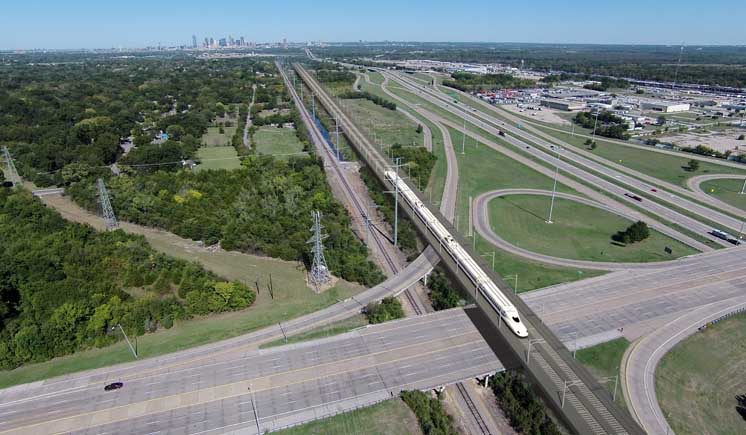
DALLAS — The departure of Texas Central CEO Carlos Aguliar came as a news report from Spain said the company’s managerial team has departed and it lacks the necessary financing.
Aguilar announced Sunday he was departing the company via a LinkedIn posting [see “Texas Central CEO steps down,” Trains News Wire, June 14, 2022].
Aguilar’s statement referred to “news reports in the international press;” La Información, a news site based in Madrid, reported earlier this month the Texas Central project is in “hibernation” as it seeks financing, and that the managerial team had left. The project is of interest in Spain because Spanish firm Renfe signed a contract in 2021 to serve as “early operator” of the high speed rail line [see “Texas Central signs operating agreement …,” News Wire, July 15, 2021].
The website Bond Buyer reports the project was estimated to cost $10 billion when it was announced in 2012, but that has since escalated to $30 billion, with the company seeking a $12 billion Railroad Rehabilitation and Improvement Financing loan, which would be more than five times larger than any previous RRIF loan. Three legislators from Texas — U.S. Reps. Kevin Brady, Jake Ellzey, and Michael McCaul, all Republicans — have argued that Texas Central is ineligible for an RRIF loan because its planned use of Japanese Shinkansen high speed technology violates federal Buy America rules.
Other news reports have indicated Texas Central owes more than $600,000 in property taxes.
The Bond Buyer also reports a group opposing the rail project, ReRoute the Route, says the “nearly insolvent” project has failed to raise 98% of its needed funding.
A report from political news site The Texan, founded by a former Republican legislator, notes the Texas Central website no longer lists any executive team members. It also quotes an email from Judge Trey Duhon, a board member of the rail project’s most vocal opponents, Texans Against High Speed Rail. Duhon wrote that Aguilar’s announcement on LinkedIn “speaks to the company’s lack of staff, lack of resources, and lack of leadership, with no successful path forward. … It is abundantly clear that this project is more than dead in the water, especially when the captain jumps ship.”
Aguilar’s departure also comes as the Texas Supreme Court considers a case, Miles vs. Texas Central Railroad & Infrastructure, to determine whether the project has the ability to acquire property through eminent domain. The Bond Buyer says that ruling is expected this month.














Other than some temporary plant set-ups for a one time contract, are there really anyone manufacturing high-speed passenger equipment in the US? If not, the Buy American clause can be waived.
“because its planned use of Japanese Shinkansen high speed technology violates federal Buy America rules.”
Well until an American company comes along we’ll just lag behind the World in the Texas GOP’s eyes.
Have I been that for off when I have thought, all along, that this project would never happen?
A mega-project of this size requires the active and supportive involvement of the government, which Texas Central doesn’t have, as the state government mostly
opposes it. Somewhere between the “all-private” Texas Central and “all-private” CaHSR Project there is a successful model for HSR in America, a “public-private partnership” where the government mostly plans and funds (state bonds and federal grants + some private funding) the a project designed, built, and run by the private sector. The long-term success and initial short-term financial failures of the Channel Tunnel/Eurostar/HS1 and Taiwan Shinkansen shows the importance of public financing and the benefits of private management. The current planning, construction, and operation of the Japanese Shinkansen is a good example of successful private-public partnership on building new HSR lines.
that’s “all public” CaHSR project… sorry for typo… 🙂
Good info Ben but just to clarify the original shinjansens was all govt or govt controlled as they were built under the old JNR era nit the current privatized JR model
Yes, JNR built a large portion of the current system, but Shinkansen construction had been slow but steadily underway since then. Currently the division in financing of new HSR lines is like half from the central government, quarter from the local government, and the rest from loans paid off through the long-term lease of the line to the JR operating company.
Having ridden Brightline several times, I agree that it would be a good candidate to improve passenger rail in my home state of Texas. It would also be a golden opportunity for Amtrak.
The best way forward to improving passenger rail in Texas is to upgrade the existing routes between Dallas and Houston, Dallas/Fort Worth and San Antonio, Houston and San Antonio, etc.
A successful operator needs to offer a service that competes favorably with driving, i.e., time, cost, comfort, dependability, etc., since that would be the source of most of its customers; it does not need to be a Japanese copy cat.
The article implies Texas Central is dead, but doesn’t really inform us as to the status of the project. Has any construction actually taken place?
No, just planning and lining up land for the ROW.
Brightline’s opportunity to enter the Texas Triangle (Houston – Dallas – San Antonio – Houston) market becomes more possible. It would be similar to the Florida and Las Vegas – Los Angeles projects which are more practical.